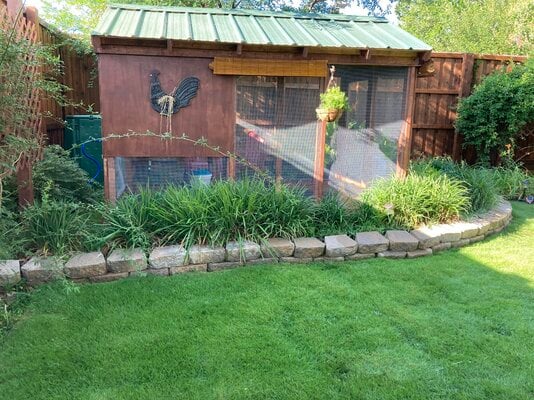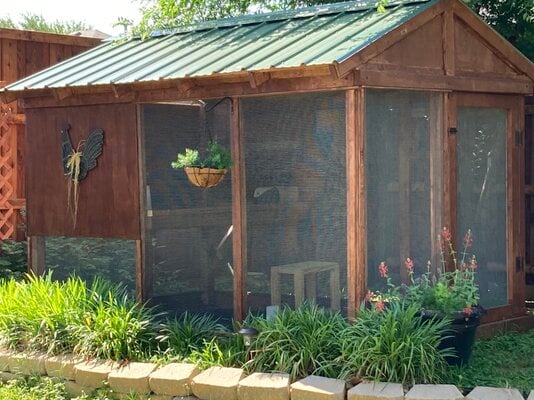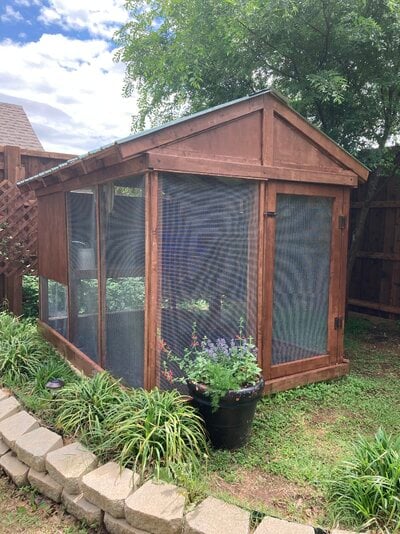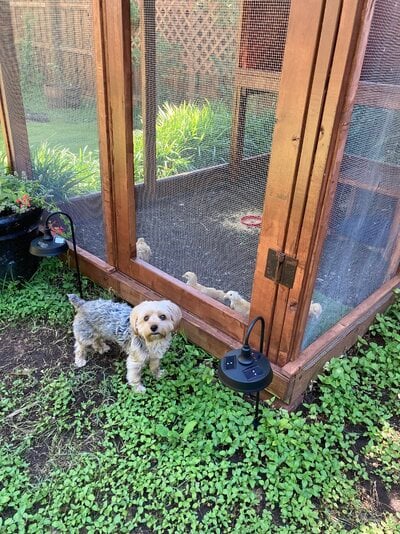impr3
Songster
We're currently in the planning phase for an open air coop/run combo on our rural Northern California homestead. I've spent the last week reading through every open air coop and Woods coop thread I can find on BYC and am so grateful for the amazing examples and tips everyone has shared! That said, customizing our coop design to our specific climate has brought up a few unanswered questions and I'm hoping some folks here will be able to share your experiences with the following:
~ How open is best in a setting with very hot dry summers and cool (but rarely freezing ) wet winters? Seems like a more enclosed coop like the Woods (https://www.backyardchickens.com/threads/woods-style-10-x-16-coop-build.1551532/) would be overkill in Northern California, but a super open option like Jen's Hens (https://www.backyardchickens.com/articles/jens-hens-a-southern-texas-coop.75707/) might be too drafty/wet. For reference, summers run 60-110F (16-43C) including night time lows and daytime highs, humidity is 10-50% and there's no rain at all from at least May-September. Winters run 20-70F (-7-21C), humidity 60-100%, and 60-120" of rainfall all crammed into 6-7 months (1.5-3 times the national average annual rainfall for the US). We occasionally get snow but it's rare that it sticks and I've never seen it stay below freezing for a whole day. Winter winds can be viscous and get into the 30-40s mph routinely and 50s mph occasionally.
Our current plan is an 8'x12' stick frame box fully wrapped in hardware cloth with semi-removable wall coverings (rusty old roofing material that we already have) over the hardware cloth. The west end will be fully enclosed on three sides (+/- a few inches of vent at the top), then progressively shorter wall coverings will be attached along the north and east walls until there is little to no covering on the remainder of the south wall (except for the 4' section at the west end that forms part of the three sided western enclosure). I'd rather not have to remove, cut down, and replace the panels at a later time, but it should be possible (hence "semi" removable). Worst comes to worst we could even take some off every summer and add them back in the winter...
~ Do visible predators distress birds in open air coops? We have a coyote pack who like to come close at night and tease our dogs. I'm pretty sure our plan is coyote proof, but I am concerned that having the coyotes staring at them through the wire at night might distress the birds... I'm particularly concerned about the ducks who will likely be sleeping at ground level. I've considered having at least 2' of wall coverings all the way around the coop/run. However, I've also heard that chickens like to be able to see out easily which this would limit. They will be able to get outside to free range during the day though so maybe that is less important.
~ How much roof overhang do folks use on your open air coops in windy places? While several threads mention recommending big overhangs, the only specific measurement I found was to have them be at least 1'. Given the high winds we get in the winter, I am currently thinking 2' overhangs for our coop/run (the whole thing will be covered) with recognition that it's likely some rain will still get in through the sections with shorter or no wall coverings. Last night rain made it 5' back under the 10' overhangs around our barn (admittedly the barn roof is about 14' off the ground instead of the 8' the highest side of the chicken coop will reach, so it's unlikely rain will blow quite so far into the coop). I'm thinking that the birds will be ok so long as the majority of the area is staying dry. What have y'all found?
Thanks everyone for your input! For those who are reading this thread to get ideas for your own open air coop, below are some links to other threads that have been super useful in planning this coop:
Open air coops:
https://www.backyardchickens.com/threads/woods-style-10-x-16-coop-build.1551532/
https://www.backyardchickens.com/threads/8-x-12-woods-coop-design-plan.1221551/
https://www.backyardchickens.com/articles/jens-hens-a-southern-texas-coop.75707/
https://www.backyardchickens.com/articles/hot-climate-chicken-housing-and-care.77263/
https://www.backyardchickens.com/threads/large-open-air-coop-in-central-nc.1443812/
Since this will be for both chickens and ducks (and I've never kept ducks before), I also found the following duck coop article particularly helpful:
https://insteading.com/blog/duck-coop/
~ How open is best in a setting with very hot dry summers and cool (but rarely freezing ) wet winters? Seems like a more enclosed coop like the Woods (https://www.backyardchickens.com/threads/woods-style-10-x-16-coop-build.1551532/) would be overkill in Northern California, but a super open option like Jen's Hens (https://www.backyardchickens.com/articles/jens-hens-a-southern-texas-coop.75707/) might be too drafty/wet. For reference, summers run 60-110F (16-43C) including night time lows and daytime highs, humidity is 10-50% and there's no rain at all from at least May-September. Winters run 20-70F (-7-21C), humidity 60-100%, and 60-120" of rainfall all crammed into 6-7 months (1.5-3 times the national average annual rainfall for the US). We occasionally get snow but it's rare that it sticks and I've never seen it stay below freezing for a whole day. Winter winds can be viscous and get into the 30-40s mph routinely and 50s mph occasionally.
Our current plan is an 8'x12' stick frame box fully wrapped in hardware cloth with semi-removable wall coverings (rusty old roofing material that we already have) over the hardware cloth. The west end will be fully enclosed on three sides (+/- a few inches of vent at the top), then progressively shorter wall coverings will be attached along the north and east walls until there is little to no covering on the remainder of the south wall (except for the 4' section at the west end that forms part of the three sided western enclosure). I'd rather not have to remove, cut down, and replace the panels at a later time, but it should be possible (hence "semi" removable). Worst comes to worst we could even take some off every summer and add them back in the winter...
~ Do visible predators distress birds in open air coops? We have a coyote pack who like to come close at night and tease our dogs. I'm pretty sure our plan is coyote proof, but I am concerned that having the coyotes staring at them through the wire at night might distress the birds... I'm particularly concerned about the ducks who will likely be sleeping at ground level. I've considered having at least 2' of wall coverings all the way around the coop/run. However, I've also heard that chickens like to be able to see out easily which this would limit. They will be able to get outside to free range during the day though so maybe that is less important.
~ How much roof overhang do folks use on your open air coops in windy places? While several threads mention recommending big overhangs, the only specific measurement I found was to have them be at least 1'. Given the high winds we get in the winter, I am currently thinking 2' overhangs for our coop/run (the whole thing will be covered) with recognition that it's likely some rain will still get in through the sections with shorter or no wall coverings. Last night rain made it 5' back under the 10' overhangs around our barn (admittedly the barn roof is about 14' off the ground instead of the 8' the highest side of the chicken coop will reach, so it's unlikely rain will blow quite so far into the coop). I'm thinking that the birds will be ok so long as the majority of the area is staying dry. What have y'all found?
Thanks everyone for your input! For those who are reading this thread to get ideas for your own open air coop, below are some links to other threads that have been super useful in planning this coop:
Open air coops:
https://www.backyardchickens.com/threads/woods-style-10-x-16-coop-build.1551532/
https://www.backyardchickens.com/threads/8-x-12-woods-coop-design-plan.1221551/
https://www.backyardchickens.com/articles/jens-hens-a-southern-texas-coop.75707/
https://www.backyardchickens.com/articles/hot-climate-chicken-housing-and-care.77263/
https://www.backyardchickens.com/threads/large-open-air-coop-in-central-nc.1443812/
Since this will be for both chickens and ducks (and I've never kept ducks before), I also found the following duck coop article particularly helpful:
https://insteading.com/blog/duck-coop/






 .
.
